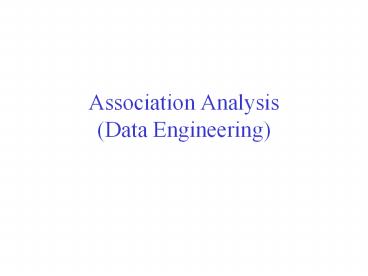Association Analysis (Data Engineering) - PowerPoint PPT Presentation
Title: Association Analysis (Data Engineering)
1
Association Analysis(Data Engineering)
2
Type of attributes in assoc. analysis
- Association rule mining assumes the input data
consists of binary attributes called items. - The presence of an item in a transaction is also
assumed to be more important than its absence. - As a result, an item is treated as an asymmetric
binary attribute. - Now we extend the formulation to data sets with
symmetric binary, categorical, and continuous
attributes.
3
Type of attributes
- Symmetric binary attributes
- Gender
- Computer at Home
- Chat Online
- Shop Online
- Privacy Concerns
- Nominal attributes
- Level of Education
- State
- Example of rules
- Shop Online Yes ? Privacy Concerns Yes.
- This rule suggests that most Internet users who
shop online are concerned about their personal
privacy.
4
Transforming attributes into Asymmetric Binary
Attributes
- Create a new item for each distinct
attribute-value pair. - E.g., the nominal attribute Level of Education
can be replaced by three binary items - Education College
- Education Graduate
- Education High School
- Binary attributes such as Gender are converted
into a pair of binary items - Male
- Female
5
Data after binarizing attributes into items
6
Handling Continuous Attributes
- Solution Discretize
- Example of rules
- Age?21,35) ? Salary?70k,120k) ? Buy
- Salary?70k,120k) ? Buy ? Age ?28, ?4
- Of course discretization isnt always easy.
- If intervals too large may not have enough
confidence - Age ? 12,36) ? Chat Online Yes (s 30, c
57.7) (minconf60) - If intervals too small may not have enough
support - Age ? 16,20) ? Chat Online Yes (s 4.4, c
84.6) (minsup15)
7
Statistics-based quantitative association rules
- Salary?70k,120k) ? Buy ? Age ?28, ?4
- Generated as follows
- Specify the target attribute (e.g. Age).
- Withhold target attribute, and itemize the
remaining attributes. - Apply algorithms such as Apriori or FP-growth to
extract frequent itemsets from the itemized data. - Each frequent itemset identifies an interesting
segment of the population. - Derive a rule for each frequent itemset.
- E.g., the preceding rule is obtained by averaging
the age of Internet users who support the
frequent itemset - Annual Incomegt 100K, Shop Online Yes
- Remark Notion of confidence is not applicable to
such rules.
8
Concept Hierarchies
9
Multi-level Association Rules
- Why should we incorporate a concept hierarchy?
- Rules at lower levels may not have enough support
to appear in any frequent itemsets - Rules at lower levels of the hierarchy are overly
specific e.g., - skim milk ? white bread,
- 2 milk ? wheat bread,
- skim milk ? wheat bread, etc.
- are all indicative of association between milk
and bread
10
Multi-level Association Rules
- How do support and confidence vary as we traverse
the concept hierarchy? - If X is the parent item for both X1 and X2, and
they are the only children, then ?(X) ?(X1)
?(X2) (Why?) - Because X1, and X2 might appear in the same
transactions. - If ?(X1 ? Y1) minsup, and X is parent of
X1, Y is parent of Y1 then ?(X ? Y1) minsup - ?(X1 ? Y) minsup
- ?(X ? Y) minsup
- If conf(X1 ? Y1) minconf,then conf(X1 ? Y)
minconf
11
Multi-level Association Rules
- Approach 1
- Extend current association rule formulation by
augmenting each transaction with higher level
items - Original Transaction skim milk, wheat bread
- Augmented Transaction skim milk, wheat bread,
milk, bread, food - Issue
- Items that reside at higher levels have much
higher support counts - if support threshold is low, we get too many
frequent patterns involving items from the higher
levels
12
Multi-level Association Rules
- Approach 2
- Generate frequent patterns at highest level
first. - Then, generate frequent patterns at the next
highest level, and so on. - Issues
- May miss some potentially interesting cross-level
association patterns. E.g. - skim milk ? white bread,
- 2 milk ? white bread,
- skim milk ? white bread
- might not survive because of low support, but
- milk ? white bread
- could.
- However, we dont generate a cross-level itemset
such as - milk, white bread
13
Mining word associations (in Web)
Document-term matrix Frequency of words in a
document
- Itemset here is a collection of words
- Transactions are the documents.
- Example
- W1 and W2 tend to appear together in the same
documents. - Potential solution for mining frequent itemsets
- Convert into 0/1 matrix and then apply existing
algorithms - Ok, but looses word frequency information
14
Normalize First
- How to determine the support of a word?
- First, normalize the word vectors
- Each word has a support, which equals to 1.0
- Reason for normalization
- Ensure that the data is on the same scale so that
sets of words that vary in the same way have
similar support values.
15
Association between words
- E.g. How to compute a meaningful normalized
support for W1, W2? - One might think to sum-up the average normalized
supports for W1 and W2. - s(W1,W2)
- (0.40.33)/2 (0.40.5)/2 (0.20.17)/2
- 1
- This result is by no means an accident. Why?
- Averaging is useless here.
16
Min-APRIORI
- Use instead the min value of normalized support
(frequencies).
Example s(W1,W2) min0.4, 0.33
min0.4, 0.5 min0.2, 0.17 0.9
s(W1,W2,W3) 0 0 0 0 0.17 0.17
17
Anti-monotone property of Support
Example s(W1) 0.4 0 0.4 0 0.2
1 s(W1, W2) 0.33 0 0.4 0 0.17
0.9 s(W1, W2, W3) 0 0 0 0 0.17 0.17
So, standard APRIORI algorithm can be applied.

